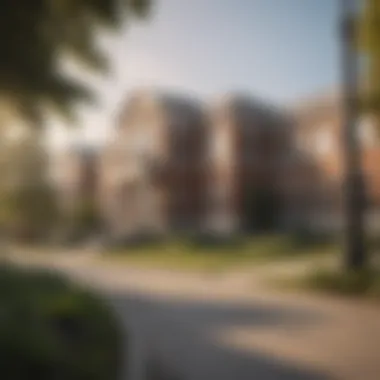Discover the Best Chicago Suburbs to Live In


Intro
The suburbs surrounding Chicago have long attracted families and individuals seeking a harmonious blend of urban access and tranquil living. This article delves into the characteristics and intricacies of several notable suburbs, focusing on their housing markets, educational opportunities, and community amenities. For potential homebuyers or relocators, understanding these factors is crucial in making informed decisions about their living environment. Examining the lifestyle benefits provides a better perspective on what these suburbs offer.
Through a detailed exploration, readers will gain insights into the unique appeal of each area and discover what makes them desirable places to live.
Featured Homes
When considering a move to a suburban area, the housing market often ranks as a primary concern. Various suburbs of Chicago feature a diverse range of architectural styles and home designs, catering to different tastes and needs.
Architectural Highlights
Chicago's suburbs present an enticing architectural palette. Here, residents encounter an array of structures from traditional colonial homes to modern builds with sleek lines. The classic residents in suburbia often opt for single-family homes, while townhouses and condos can also be found in several areas. Some notable architectural trends include:
- Bungalows that reflect Chicago's rich history.
- Craftsman designs that provide warmth and character.
- Contemporary homes with open floor plans and green building principles.
Each architectural style not only defines the aesthetic of the neighborhood but also influences the overall community vibe. Buyers can find historic districts with meticulously preserved homes, offering a sense of nostalgia, while newly developed areas may focus on sustainability as a selling point.
Interior Design Themes
Inside these homes, interior design often mirrors the preferences and lifestyles of residents. Various themes highlight personal expression and comfort. Common trends include:
- Minimalism: This approach emphasizes uncluttered spaces and functionality.
- Eclectic Styles: Mixing vintage finds with modern pieces showcases personality.
- Traditional Designs: Featuring rich woods and classic details contribute to a timeless feeling.
Potential homeowners should consider how interior design aligns with their lifestyle needs and preferences, as this can significantly impact their overall satisfaction with their home.
Location Spotlights
Beyond housing, the suburban landscape of Chicago offers much more. Areas provide beautiful natural settings and culturally significant locations, adding to their desirability.
Cultural Significance
Cultural amenities enrich the suburban experience. Many Chicago suburbs are home to local theaters, art galleries, and historical sites. They often serve as hubs for community gatherings and events, fostering a sense of belonging. Examples include:
- Theatres: Offering performances from local troupes and bigger productions.
- Art Festivals: Celebrating local talent and fostering community engagement.
- Museums: Showcasing regional history and art.
These cultural aspects enhance the quality of life for residents, turning suburbs into vibrant communities.
Natural Wonders
The proximity to nature significantly contributes to a suburb's appeal. Access to parks, trails, and scenic lakes showcases the natural beauty surrounding these communities. Residents can enjoy outdoor activities like hiking, biking, and picnicking. Benefits of green spaces are numerous:
- Provide areas for relaxation and recreation.
- Promote physical health through active lifestyles.
- Encourage social interactions among neighbors.
Suburbs that prioritize connecting with nature often draw families and individuals seeking a balanced lifestyle.
In summary, the exploration of Chicago's suburbs reveals diverse options for housing and community experiences. By considering architectural styles, interior themes, cultural offerings, and natural beauty, potential residents can make informed decisions that align with their lifestyles and preferences.
Prelims to Chicago Suburbs
The suburbs of Chicago play a crucial role in shaping the overall character and living experience of the region. They offer an alternative to urban dwelling with their unique attributes, making them attractive destinations for families, professionals, and retirees alike. Understanding the dynamics of these suburbs is essential for anyone considering relocation or investment in the area.
One significant element to consider is the diversity of neighborhoods available. Each suburb houses distinct characteristics, influenced by history, demographics, and local culture. These factors contribute to the overall quality of life and opportunities for residents.
Historical Context
Chicago’s suburbs have evolved considerably over the decades. From the post-World War II expansion, when returning veterans sought homes outside crowded city limits, to the modern day, these areas have transformed dramatically. The industrial boom and subsequent urban migration laid the groundwork for suburbia as we know it today.


Initially, suburbs were established primarily for housing. As transportation improved, particularly with the advent of the automobile, commuting to downtown Chicago became more feasible. This accessibility encouraged more people to move to these areas, fundamentally changing their nature. Many suburbs developed their own identities with business districts, schools, and parks to cater to the growing population.
Today, the historical significance of these suburbs reflects in their architecture and community structures. Many neighborhoods have preserved elements of their past while adapting to contemporary needs.
Present-Day Demographics
The demographics of Chicago's suburbs reveal a tapestry of cultures and backgrounds. Recent data indicates a marked increase in diversity, bringing together populations from various ethnicities and socioeconomic backgrounds.
Factors such as job opportunities, quality of education, and safety contribute to these demographic changes. Each suburb attracts a blend of younger families, established professionals, and retirees, fostering vibrant community interactions. The suburbs often serve as a melting pot, melting away the geographical boundaries that once defined them.
In summary, the suburbs surrounding Chicago are not merely extensions of the city but stand as multifaceted communities with their own unique histories and demographics. This understanding provides a valuable framework for prospective residents and investors seeking to tap into the rich environment of suburban life.
Criteria for Evaluating Suburbs
Evaluating the suburbs surrounding Chicago is crucial for potential homebuyers and relocators. This section outlines the primary criteria one should consider when assessing the desirability of a suburb. Each criterion reflects essential elements that influence quality of life, convenience, and overall satisfaction with a living space.
Housing Affordability
Housing affordability stands out as a primary concern for many families and individuals contemplating a move to the suburbs. It encompasses not only the price of homes but also property taxes, homeowner association fees, and ongoing maintenance costs. While some suburbs offer attractive housing stock at lower prices, others may present hidden costs. Understanding these financial implications is vital for making informed decisions. A suburb that seems affordable initially may become less so when long-term costs are factored in.
Educational Opportunities
Educational opportunities significantly impact families' choices of a suburb. Access to reputable public and private schools, as well as proximity to higher education institutions, plays a critical role in evaluating the quality of a community. Areas with blue-ribbon schools often have better property values and a reputation for family-friendliness. Furthermore, educational resources like libraries and after-school programs contribute to a suburb's appeal for families with children, shaping the community's future.
Community Amenities
Amenities contribute to the lifestyle quality in a suburb. Parks, recreation centers, shopping areas, and cultural attractions make a neighborhood more vibrant and livable. Residents often seek neighborhoods with libraries, community events, and local art scenes. Access to these amenities affects daily life and affects the potential for social interactions. Well-maintained common areas can enhance community pride and foster a sense of belonging.
Public Safety and Crime Rates
Public safety directly influences the quality of life. An assessment of crime rates and law enforcement effectiveness is crucial for families and individuals prioritizing safety. While suburbs may boast lower crime rates than urban areas, isolated incidents can shift perceptions. Resources invested in community policing and neighborhood watch programs also contribute positively to feelings of safety, allowing residents to feel secure in their homes.
Transportation and Commute Times
Transportation options and commute times are practical considerations for daily life. Suburbs with access to public transit like the Metra provide a vital connection to Chicago, significantly impacting the appeal for professionals commuting to the city. Short commute times can enhance work-life balance, reducing stress and increasing leisure time. Furthermore, the availability of major thoroughfares and proximity to expressways facilitate easier access to nearby attractions and resources.
Prominent Suburbs to Consider
Analyzing the prominent suburbs around Chicago is key for anyone looking to relocate or invest in real estate. These suburbs offer diverse options and contribute significantly to the overall appeal of the Chicago metropolitan area. Each suburb has distinct characteristics, amenities, and community vibes.
When evaluating potential neighborhoods, factors like housing styles, school quality, and local attractions come into play. This section will delve deep into five notable suburbs, offering insights that highlight their unique selling points.
Evanston
Evanston is located just north of Chicago and showcases a blend of urban energy and suburban calm. Known for its proximity to Lake Michigan, it provides many recreational options. Housing in Evanston features a mix of modern apartment complexes and charming single-family homes, appealing to both young professionals and families.
The presence of Northwestern University adds a youthful dynamism. The area boasts excellent public schools and rich cultural activities, such as theatres and museums.
Additionally, Evanston has a vibrant downtown. Residents enjoy a variety of dining options and shopping experiences, making it convenient for daily needs.
"Evanston is a prime example of how historical charm fuses with modern living."
Naperville
Naperville is renowned for its high quality of life and is frequently ranked among the best places to live in the United States. The suburb has a strong sense of community. Single-family homes with large yards are common, making it ideal for families.
The Naperville Riverwalk is a notable feature, offering scenic views and recreational activities. Schools in Naperville consistently earn accolades for academic performance, a vital consideration for families with children.
In terms of amenities, Naperville impresses with a selection of retail centers, restaurants, and cultural events. This suburb represents suburban living at its best, providing residents with a well-rounded lifestyle.


Oak Park
Often recognized for its architectural heritage, Oak Park is home to many Frank Lloyd Wright-designed buildings. This suburb attracts those interested in culture and history. The housing market here offers a range, from vintage homes to contemporary options.
Local schools are well-respected, making Oak Park a prime choice for families. Furthermore, the suburb features a thriving arts scene, with galleries and theaters enriching the community experience.
Accessible public transportation facilitates easy commuting to downtown Chicago, appealing to professionals. Overall, Oak Park blends culture, education, and community cohesiveness.
Arlington Heights
Arlington Heights is characterized by its spacious parks and family-friendly atmosphere. The suburb features an array of housing options, including townhomes and single-family residences. Community events throughout the year foster a strong neighborhood spirit.
Schools are highly rated, which attracts families seeking a nurturing educational environment. Local amenities include shopping areas, public libraries, and recreational facilities.
Arlington Heights also has an active downtown with dining and entertainment options. Consequently, it presents a well-rounded lifestyle for its residents.
Hinsdale
Hinsdale is noted for its affluent lifestyle and picturesque neighborhoods. The property values are higher than in some other suburbs, reflecting the demand for high-quality living standards.
Historically, Hinsdale has maintained its charm, with tree-lined streets and beautiful older homes. Families often flock to Hinsdale, drawn by excellent educational facilities. The suburb prioritizes safety and community wellness, enhancing its appeal.
Shopping and dining options abound, with a quaint downtown that includes vibrant cafes and boutiques. Above all, Hinsdale embodies a desirable suburban lifestyle.
Through exploring these suburbs, it is evident that each location offers distinct advantages, appealing to various lifestyles and preferences. The choice ultimately lies in aligning individual needs with what each suburb has to offer.
Lifestyle and Cultural Offerings
Lifestyle and cultural offerings play a significant role in the appeal of Chicago's suburbs. These elements not only define community identity but also enhance daily living experiences. Potential homebuyers and relocatees often seek areas that provide enriching cultural activities and lifestyle amenities. Those factors contribute to the feeling of belonging and satisfaction in their living environment.
Arts and Entertainment
Chicago’s suburbs host a rich tapestry of arts and entertainment options that cater to diverse tastes. Local theaters, galleries, and music venues serve as platforms for both emerging artists and established professionals. Some suburbs like Evanston boast the historic Evanston Arts Center which offers visual arts programs. Moreover, events such as art walks and film festivals showcase local talent and provide opportunities for community engagement.
Generous investments in cultural institutions draw residents seeking both aesthetic delight and intellectual stimulation.
"Cultural experiences can transform a community, making it vibrant and appealing to a wide range of residents."
Dining and Nightlife
The dining scene in suburban Chicago is varied and vibrant. Local establishments range from cozy cafes to upscale restaurants, providing choices for every palate. For example, Naperville features a variety of dining options along its charming Riverwalk, with influences from various cuisines. Additionally, food festivals and farmer's markets enhance the culinary landscape, promoting local goods and fostering a sense of community.
Nightlife in the suburbs may not match the urban hustle, yet it offers quality experiences. Many neighborhoods host bars, live music venues, and casual eateries where residents can unwind. The atmosphere is often more inviting, making it suitable for families and professionals alike.
Parks and Recreation
Access to parks and recreational facilities is a crucial aspect of suburban life. Green spaces contribute to physical health and social interactions. The suburbs of Chicago feature well-maintained parks, sports facilities, and hiking trails within a short distance. Some areas, like Arlington Heights, prioritize outdoor beauty through park districts that organize activities for all age groups.
Families often take advantage of playgrounds and community sports leagues, which foster connections among residents.
Real Estate Trends
Understanding the real estate trends in Chicago's suburbs is essential for those considering a move or investment. The dynamics of the housing market can provide valuable insights into where to buy, when to sell, and how to maximize quality of life. Trends in real estate reflect the broader economic landscape and can significantly impact individual and family decisions regarding housing.
Market Overview
The current market environment for Chicago's suburbs shows varied activity. Home prices in areas like Evanston and Naperville have seen an increase over the recent years, driven by demand for more space and suburban amenities. In contrast, some suburbs are experiencing stabilization in prices as inventory levels adjust. The average cost of a single-family home in these prominent suburbs can range from $300,000 to over a million dollars, depending on location and specific features.
It is important to analyze the months of inventory available; a lower number indicates a seller's market, while a more elevated inventory level signifies a buyer's market. Factors such as school district ratings, local economic conditions, and transportation facilities also play a critical role in shaping these trends. For instance, the every-growing family demographic often causes neighborhoods with strong educational opportunities to attract more potential buyers.
Investment Potential
Investment potential in Chicago suburbs can be very promising. Areas with consistent rental demand, such as Oak Park and Arlington Heights, offer substantial returns for property owners and buyers seeking long-term financial growth. Analyzing rental yields and historical price appreciation helps identify the suburbs with the best investment prospects.


Moreover, economic growth indicators, such as declining unemployment rates and infrastructure development, signal favorable conditions for real estate investments. The suburbs benefit from Chicago's ongoing urban development, making them attractive to those looking for opportunities outside the city's core while still enjoying the amenities of urban life.
"Investors should always consider local socioeconomic factors before committing to a property. Suburbs with strong community engagement tend to maintain their real estate values better."
Overall, the landscape for suburban real estate in Chicago presents unique opportunities. Being informed can significantly enhance decision-making related to purchases or investments in these desirable communities.
Challenges Facing Suburban Living
When contemplating a move to the suburbs of Chicago, it is crucial to understand the potential challenges that one might encounter. While suburbs can offer numerous advantages, they are not without their issues. Addressing these challenges helps prospective residents grasp both the positive and negative aspects, ensuring well-informed relocation decisions.
Urban Sprawl
Urban sprawl often characterizes many suburbs surrounding Chicago. This term refers to the expansive growth of urban areas into rural or undeveloped land. One immediate result of urban sprawl is the increased reliance on vehicles. Long commutes can lead to traffic congestion and reduce time spent with family or engaging in leisure activities.
As suburbs extend outward, essential services and amenities may not keep pace with the rapid development. This can create difficulties in accessing schools, parks, and healthcare facilities. Communities may lack cohesion, as residents are often isolated due to the vast distances between homes and public spaces. Therefore, it's important to evaluate community planning initiatives before deciding on a suburb to minimize the impact of sprawl.
Cost of Living Concerns
While many suburbs are perceived as affordable alternatives to city living, cost of living can vary significantly across different areas. Factors such as property taxes, local prices of goods and services, and housing market dynamics play vital roles in determining overall expenses. A suburb that appears attractively priced might be burdened by high property taxes, making it less affordable in the long run.
Moreover, the need for services like child care, health programs, and recreational opportunities can add extra financial pressure. Some suburbs, despite lower housing prices, may lack adequate access to these essential services, which could increase overall costs for households, especially families.
Understanding the comprehensive cost of living, alongside individual financial capacity, is important for choosing the right suburb. Hence, potential residents should analyze economic factors thoroughly before making a commitment.
"Awareness of suburban challenges enables potential residents to make better-informed decisions about their living arrangements and long-term satisfaction."
By systematically assessing urban sprawl and cost of living concerns, those interested in suburban living can weigh their options more effectively. This careful analysis leads to a more satisfactory and sustainable living experience.
Comparative Advantages and Disadvantages
Understanding the comparative advantages and disadvantages of suburban living versus urban living is essential for potential homebuyers and relocators. Each option provides distinct experiences, and recognizing these differences can significantly influence one's lifestyle choice. This section will delve into specific elements such as space, amenities, and overall quality of life.
Suburbs vs Urban Living
Suburban areas tend to offer several advantages over urban environments. For instance, homes in suburbs usually come with larger spaces, both indoors and outdoors. This appeals to families, as children can play outside, and adults can enjoy gardens or yards. Additionally, suburbs are often perceived to have a slower pace of life. Commute times can vary, but many suburbs boast access to reliable public transport, easing the transition to and from the city.
However, urban living also has its merits. Residents benefit from being close to workplaces, entertainment options, and cultural experiences. Cities often provide more diverse dining options and vibrant nightlife scenes, which many individuals seek. Thus, the decision between suburbs and urban living hinges heavily on personal preferences and lifestyle priorities.
Quality of Life Considerations
Quality of life is a vital consideration in the debate between suburban and urban living. Factors such as safety, schools, recreational activities, and community engagement differ significantly between the two. Suburbs often report lower crime rates, making them attractive for families and those seeking peace of mind. Furthermore, educational opportunities in suburban areas can frequently be superior, with many suburbs hosting well-rated public schools.
On the other hand, urban settings can provide a rich cultural tapestry, exposing residents to an array of social experiences. Public transportation availability often enhances connectivity, making it easier to participate in various events and activities.
In the end, understanding the comparative advantages and disadvantages helps readers weigh their options more effectively. Making an informed choice can lead to greater satisfaction in one’s living situation.
Key insight: Each lifestyle option presents its unique set of advantages and disadvantages, requiring an introspective look at one’s priorities.
Ending
In this exploration of the most attractive suburbs in Chicago, it is essential to underscore the nuanced aspects of the suburban experience. These areas stand out not only for their housing options but also for their community dynamics, educational environments, and overall livability. The suburbs exhibit a distinct character that can significantly enhance the quality of life for families and individuals alike.
Recap of Key Points
To summarize, we have examined several critical factors influencing suburban preferences. Key considerations include:
- Housing Affordability: Most suburbs provide a range of options, making them attractive for various income levels.
- Educational Opportunities: Access to high-quality schools is a top priority for families, directly impacting residency decisions.
- Community Amenities: Parks, libraries, and recreational facilities greatly enrich the living environment.
- Public Safety and Crime Rates: Safety remains a primary concern, with many suburbs boasting low crime rates, contributing to their appeal.
- Transportation and Commute Times: Proximity to public transport and major roadways eases the daily commute, making suburban living feasible for city workers.
Final Thoughts
As urbanization trends continue, the suburbs offer a compelling alternative for those seeking a more balanced lifestyle. They blend the convenience of city access with the tranquility of residential living. For potential homebuyers, understanding these suburbs' unique characteristics aids in making informed choices. Ultimately, recognizing the advantages and challenges associated with suburban life can lead to thoughtful decisions about where to settle.
"The right choice of suburb can transform your living experience, bridging comfort with accessibility."
Focusing on these key insights promotes a deeper understanding of not just where to live, but why the choice matters in the grand scheme of one’s lifestyle.







